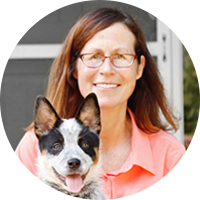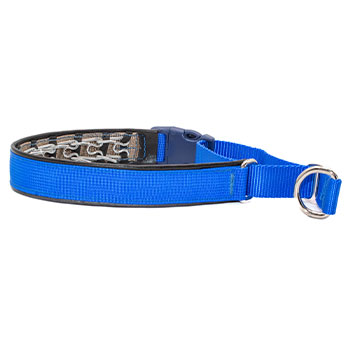April 26, 2011
Does your experience tell you my situations can be corrected for a trial situation? Secondly, would you recommend a muzzle, leashed, leave it training as the first step?
Full Question:
I have reviewed your web site and hope you could share your insight and opinion about our ability to positively resolve this situation.I have a 12 month Brittany who was one of 2 puppies (both male) in a litter I bred. Parents and grandparents had good temperaments. We compete in field trials which require 2 dogs to be turned loose together and search for birds in 30 minutes to 1 hr braces. I have 6 dogs who are all house pets; 1 female (the puppy's mother), a 13 year old neutered male, and 4 intact males ranging from 8 to 3 years. All co-exist without any aggression. My sister's female beagle also often visits without incident.
As a 8-9 week old puppy, when confronted with another small Brittany puppy (male) about the same age, my puppy's reaction was to growl and exhibit signs of dominance. After a correction, they both played appropriately remaining leashed the entire time. At about 4 months he also growled, hair raised, and lunged at sightly younger female puppy walked close while he was on the end of a stakeout at a field trial. Again, I made a correction, which I now realize was not severe enough apparently.
He competed in about 5 trials last spring, being loose with another strange dog without incident, although at the last trial he exhibited aggressive signs (hair raising) until receiving a verbal correction. He has been trained with his now male sibling (owned by someone else) and other strange older dogs occasionally and has clearly been the dominate dog with his sibling. He approaches the dog who rolls on his back and will stand over him. Again he has received a verbal correction which ended the behavior. He does not exhibit any dominance signs with his family dogs. He always gets his treats last in the group and is fed in a crate. He has been shown in conformation ring with incident.
Last weekend a simulated trial session, he was braced with his sibling. Upon release, he immediately attacked the other dog who was submissive to his attack. The incident was broken up when I ran towards him saying no. (Yes, I have read your article about saying no, no, no but I was not expecting such behavior and was totally surprised.) Believing that the situation was resolved, the dogs were released again and again, my dog attacked the other dog. At this point my husband had to physically grab him to resolve the situation. He was very loudly corrected and shaken (apparently not severe enough). In what now was obviously a incredibly stupid decision, we released the other dog and let him get out into the next field before letting ours go. He had on an electric collar for other training purposes. Once he could see the other dog again, even though he was not very close he immediate sought out the dog. My husband used the shock collar while yelling no but it did not prevent yet another attack.
None of the attacks drew blood but clearly, there is a problem. There is no way we can risk this happening again for all involved and unless we feel this can be successfully corrected, we will need to place the dog in a situation where he will not encounter strange dogs in a uncontrolled manner.
In order to compete he must accept being loose with strange dogs who may even bump into him. Your "leave it" command ultimately will also not always be in option since he may encounter the other dog out of the handler's presence.
My question is twofold; does your experience tell you this can be corrected for a trial situation and, secondly, would you recommend a muzzle, leashed, leave it training as the first step given where we are at now?
Any insights you could provide would be greatly appreciated.
Kathy

 Cindy's Answer:
Cindy's Answer:
This may be a tough one to solve. If it were a matter of teaching him to avoid all other dogs, this could be done but if you want to compete in trials where he's ranging loose with other dogs that may incur the aggression I have to say it's a dangerous thing to try. As a person that has years of experience with aggressive dogs, I have to say it's a challenge I would hesitate to take on.
I think the only way to deal with it is to make sure he understands 100% that his world is going to become very uncomfortable if he even looks at another dog. Since I am not familiar with how a field trial works, I don't even know if this is realistic of feasible.
I would suggest restructuring this dog's life regardless of which way your training takes you. He needs strict rules and boundaries. I have included our groundwork article, I would start this with him right away.
I would retrain this dog using our dominant dog dvd and I would double check the ecollar you are using and make sure it's operating properly and making contact. We recommend Dogtra or Tr Tronics collars, the cheaper brands just aren't reliable enough in our experience. I would also use a muzzle.
My feeling is that a field trial career may not be in the cards for this dog, because whenever you are handling a dominant and aggressive dog it's a balancing act and staying one step ahead of the situation. Prevention and management are the key, and I am afraid that neither prevention or management can take place when the dog is a distance away, off leash.
No matter what direction your training takes the dog aggression must be extinguished. At only a year old, he's not even a fully mature dog and it will only get worse if it's not dealt with properly.
Cindy
I think the only way to deal with it is to make sure he understands 100% that his world is going to become very uncomfortable if he even looks at another dog. Since I am not familiar with how a field trial works, I don't even know if this is realistic of feasible.
I would suggest restructuring this dog's life regardless of which way your training takes you. He needs strict rules and boundaries. I have included our groundwork article, I would start this with him right away.
I would retrain this dog using our dominant dog dvd and I would double check the ecollar you are using and make sure it's operating properly and making contact. We recommend Dogtra or Tr Tronics collars, the cheaper brands just aren't reliable enough in our experience. I would also use a muzzle.
My feeling is that a field trial career may not be in the cards for this dog, because whenever you are handling a dominant and aggressive dog it's a balancing act and staying one step ahead of the situation. Prevention and management are the key, and I am afraid that neither prevention or management can take place when the dog is a distance away, off leash.
No matter what direction your training takes the dog aggression must be extinguished. At only a year old, he's not even a fully mature dog and it will only get worse if it's not dealt with properly.
Cindy
100% (2 out of 2)
respondents found this answer helpful


Can't find what you're looking for?








